

The extract below is from the book Tonbridge for the Resident, the Holiday Maker and the Angler, by W. Stanley Martin and B. Prescott Row (price sixpence), written in 1896. At that time there was much building going on in the town in connection with the widening of the High Street. Over a period of years every building on the west side of the High Street from the south end up to the Big Bridge was demolished and rebuilt further back.
To help with identification, the present-day names of some of the buildings, etc, have been added in square brackets.
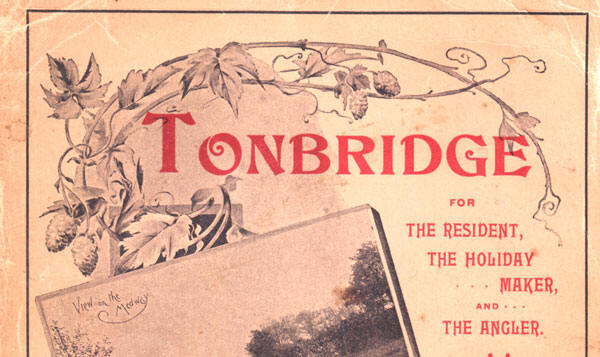
A BRIEF stroll through the town of Tonbridge may not prove uninteresting, so supposing we have just arrived from London we make the station our starting point, taking the High Street to the left hand first. The view down the High Street from the station is not perhaps attractive at the time of writing. Sundry old hits of architecture, remnants of Tonbridge past, combined with various red brick edifices staring you out of countenance, do not present many attractions to those seeking the picturesque, but there is this consolation that the farther the town is explored westward the more attractive it grows, and furthermore building and rumours of building are rife, and a little later it is possible that a handsome technical school and public offices [now Library and Adult Education Centre] will stand upon the site opposite the Angel Hotel [now Pounstretcher], where now mean property and small unattractive cottages mar the entrance to the town.
Behind the Hotel, on the right, is the far-famed Angel cricket field [now Angel Centre], scenes of many a county struggle, and headquarters of the most important town club in Kent.
The first building of note to the right is the handsome Congregational Church, an edifice built in white stone – a pleasant relief to the prevailing ruddiness of the other buildings.
A short distance further on, on the other side, are some old-fashioned houses of liliputian proportions, all doomed to destruction to make way for the more modern buildings which now adorn the High Street in ever-increasing numbers. Passing over the bridge spanning a tributary stream of the Medway we notice Ebenezer Chapel, and a little later the Baptist Chapel, both on our left.
Crossing the road we now arrive at the Bull Hotel [where Peacocks is now], an old hostel teeming with interesting associations of the past, and with vast capabilities for making its guests comfortable in the present. In its smoking room is displayed a copy of the London Gazette, dated Thursday, June 18th to June 22nd, 1685, in which, among other items of news interesting, in their day, is the following announcement : "These are to give notice that the post goes every day to and fro betwixt London and Tunbridge, and will continue to do so during the season for drinking those waters."
In the same room the late lamented Tom Sayers, of pugilistic memory, used to regale himself at the intervals in training for some of his redoubtable encounters. Tom Sayers trained at Hadlow, four miles from Tunbridge, and used to come over continually.
Another interesting and probably valuable possession of mine host of the Bull is the old signboard. It was painted by B. Herring in the thirties, and was a study from life by that well-known painter of animals – a prize bull in Mr. Deacon's park sitting for the portrait. Herring lived in the locality in those days.
This old place of entertainment contains evidence of being of considerable antiquity. Some parts of the building are evidently Elizabethan, whilst in other parts the immense rough-hewn solid beams point to a much earlier period.
At the Bull Hotel the local branch of the Ancient Order of Druids meets, and weekly congratulates itself upon being one of the strongest and most important lodges in the kingdom. References to the piscatorial trophies displayed in the coffee room are referred to in the chapter dealing with angling,
Almost opposite the Bull is a turning called New Wharf, which leads not only to the pumping station of the Water Company and the old racecourse, but to two charming bits of river scenery – first at the confluence of two branches of the Medway, and then a little further on from the landing stage of the Tonbridge Boating Club you get a lovely view down to the town, overlooking the charmingly wooded Castle grounds.
A little further on, on the left-hand side of the road, occurs a cumbersome joke in the shape of the signboard of an inn [where Wetherspoon's is now] . The signboard bears the inscription of "We three loggerheads be" and depicts two bacchanalians adorned with smiles of very expansive proportions. We leave our readers to discover for themselves where the joke comes in.
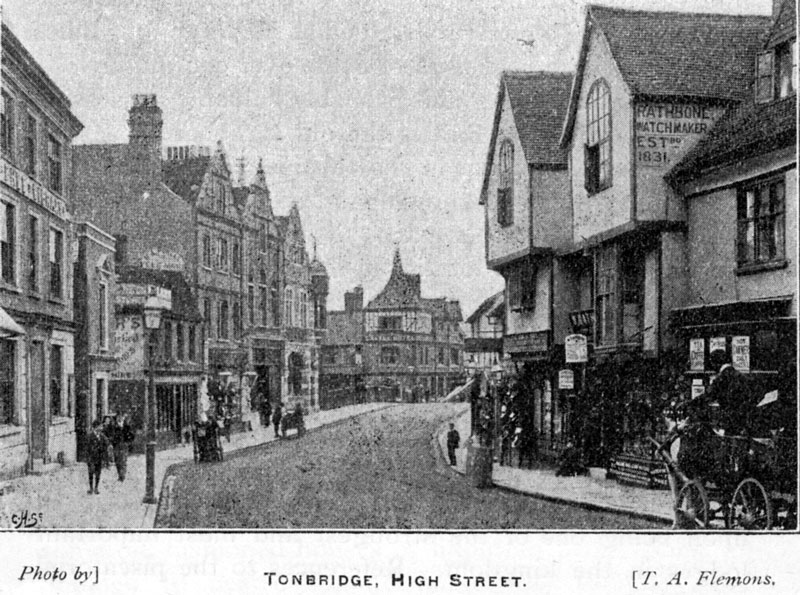
The Castle Hotel to our right is convenient for those who seek the river for boating, and a most comfortable hotel it is. The C.T.C. [Cyclists Touring Club] headquarters are here.
We now pass over the bridge that spans the main river, the Medway. This bridge was erected in 1887. You get picturesque views from the bridge on the right, of barges unloading at the wharf, and on the left, of the beautifully wooded grounds of the Castle.
After passing the bridge, to the right we notice the Post Office [now Pizza Express], the Free Library, and District Board Offices, the former a decidedly-modern building, in sharp contrast to the Old Chequers Inn on the opposite side of the road – a gabled building some five hundred years old, once the only inn in the town, and in the possession of the Colepepper family.
The prosaic-looking building that faces us is the Town Hall [demolished in 1901]. An old engraving depicting Tonbridge in the good old times shows us, hard by the Town Hall, two institutions both indicative of those genial days, namely, the Whipping Post and the Town Stocks.
The street to the right is East Street, where both the Wesleyan Chapel and the rooms of the Y.W.C.A. are situated. On the roof of the ironmonger's at the corner will be noticed a curious weathercock depicting a scene of familiar English sport – partridge shooting. There it is complete – the man with his gun, dog, and the doomed bird.
A short distance up this turning will be found a most interesting relic of the past in the Old Ivy House [now renamed Port Reeve's House], an illustration of which we include in this book. This picturesque old landmark was formerly the house of the Port Reeve, where in olden times owners of cattle coming into the town were taxed. The building is known to be over 450 years old, and an examination of its oaken beams shows it to be as good as ever, and perchance it may yet last for many more years. It now consists of three cottages, the building facing the road being once known as the Old Swan Inn. The diminutive character of its doorways cause the reflection that although "our fathers were high-minded men," they must have been exceedingly low of stature. Silk hats, beware!
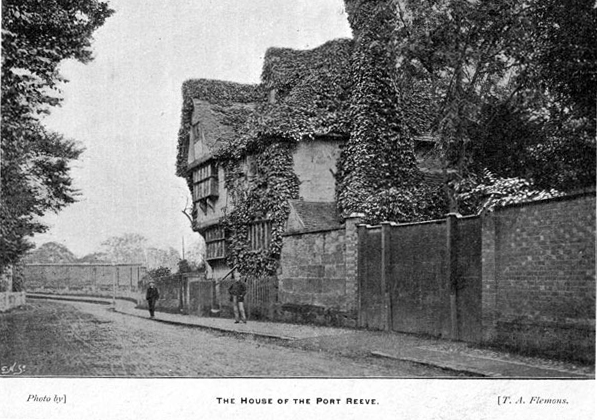
Church Street, opposite the Old Ivy House, leads into the churchyard, whence we will wend our way.
The churchyard, although very beautifully surrounded, contains few monuments of much interest. The one most worth reading is perhaps the memorial to Ann Elliot, the authoress*. It is an urn-surmounted tomb, surrounded by railings, close to the wall near to the Bordyke exit. As the inscription is difficult to decipher, we transcribe it for the benefit of our readers.
ANN ELLIOT,
DAUGHTER OF RICHARD AND MARY ELLIOT,
Born the 16th November, 1743,
Died the 30th May, 1769.
Of matchless form, adorned with wit refined,
A feeling heart and an enlightened mind,
Of softest manners, beauty's rarest bloom,
Here Elliot lies and moulders in her tomb.
Oh ! blest with genius, early snatch'd away !
The muse that joyful marked thy opening ray,
Now sad reverse ! attends thy mournful bier,
And o'er thy relicks sheds the gushing tear.
Here fancy oft the hallow'd mould shall tread,
Recall thee living and lament thee dead ;
Here friendship oft shall sigh till life be o'er,
And death shall bid thy image charm no more.
Her mother and father also repose in the same grave, the former having been exhumed from another spot in the churchyard and deposited with the body of her talented daughter.
The Church itself is of considerable antiquity, and from its tower a very extensive view of the valley of the Medway can he obtained.
Within the Church many former vicars and headmasters of the Grammar School have found their last resting place, but the memorial which will especially interest us is the one in the chancel, where two recumbent effigies will be noticed. On the higher one of the two the following inscription can be deciphered:
Here lyeth the body of Sir Anthony Denton, Knight, one of the honourable band
of pensioners (both to our late Lady Q. Elizabeth and also to our now Sovereign
Lord K. James), whose manic eminent Partes both of mind and body (equally
beholding to Nature, Arte and Grace) in his youth adorned the Court, in his
latter years the country ; in both worthylle beloved, and everywhere, with the
best, approved, to the last period of his life, which (in assured Hope of a
better) with much patience and constancie in the faith of Christ, Hee finished
August xxvi.
Anno Salv 1615.
Aeta 54
In pious memorie of whose many-fold worth, His dear and doleful wife Elizabeth (eldest daughter of Thomas Isham of Langport, in the county of North-Hampton, Esquire) erected this monument.
Christ's Death's my life, my death to life was Portal
So through two deaths I have of life immortal.
His "dear and doleful wife" reposes in the same tomb, and is represented by the lower effigy.
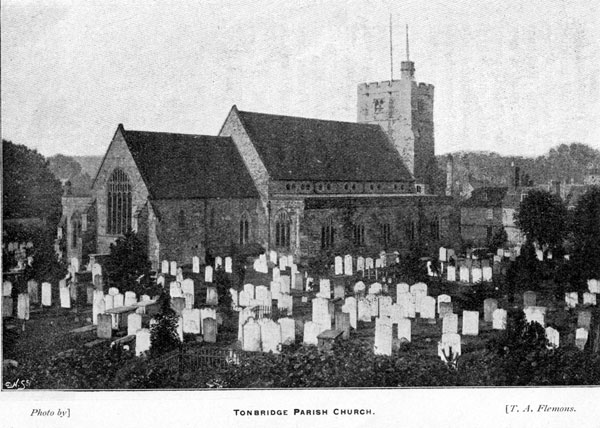
The road facing the Church porch leads us again into the High Street, passing the rooms of the Y.M.C.A. on the way.
We retrace our steps to the Rose and Crown, a fine specimen of a high-class family hotel—a coaching inn in the good old days, and honoured by the attention of our Gracious Majesty herself, who in her young days on coaching from London to Hastings changed horses and rested here. The hotel boasts a very handsome staircase, and its proprietor, Mr. T. Pawley, deserves well of the town, for as secretary and captain of the Cricket Club he has initiated the county cricket matches on the Tonbridge ground, and accordingly made the "Cricket Week" that annual and successful function that it always is.
Passing the Public Hall on the left (theatrical performances, concerts, &c.) [where Wellington Place is now], another quaint old building confronts us, which formerly did duty as a Port Reeve house. It now carries the sign of the Elephant and Castle [now The Ivy House]. The left-hand side of the road is now flanked by the noble buildings of the far-famed Grammar School. The road soon parts left and right – right to Shipbourne (which local laziness has corrupted into "Shibbun") and Ightham, and left to Sevenoaks and London. The right road is also the way to the beautifully situated Cemetery.
One main feature of the town, viz., the Castle, is referred to in another portion of the guide.
Retracing our steps to the station, and turning to the right, we note that St. Stephen's Church is the principal item of interest.
The road turning to the left is Primrose Hill, and forms the Pembury and Hastings road. The straight road, Quarry Hill, is the direct and beautiful way to Tunbridge Wells.
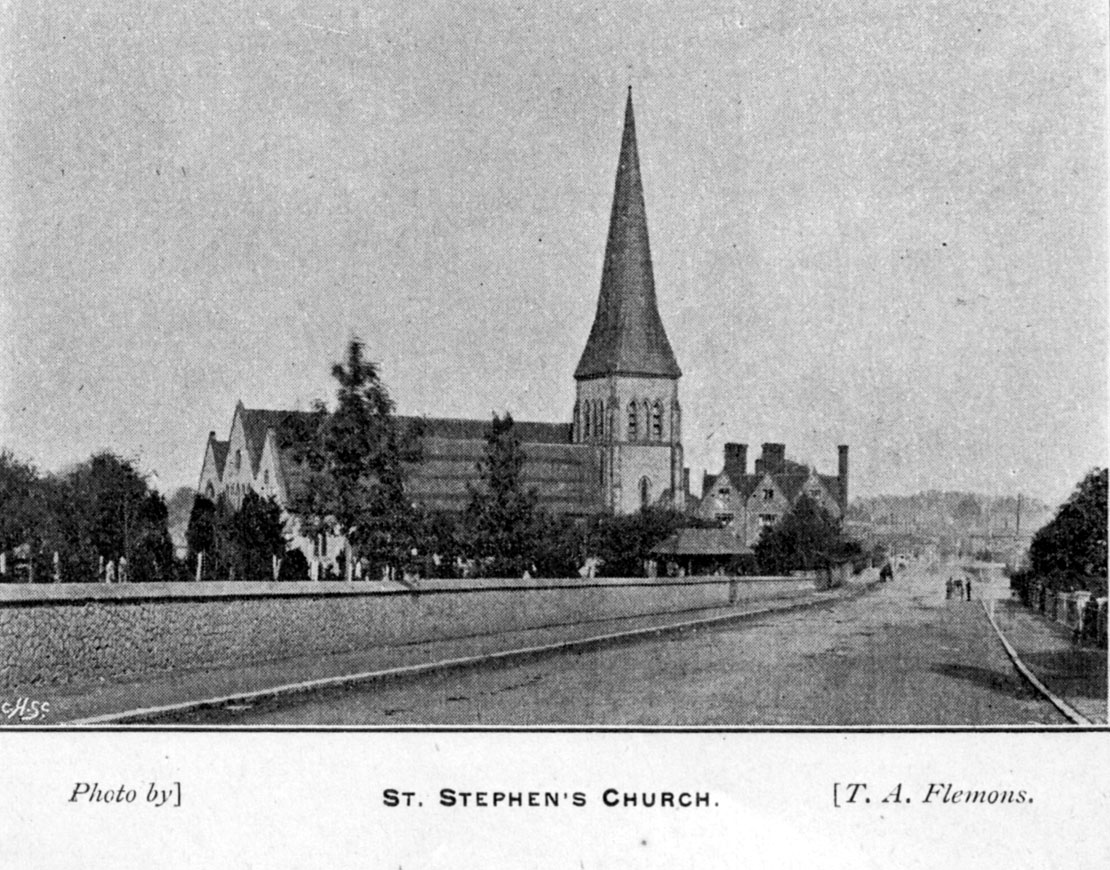
*DNB describes Ann Elliott as courtesan, actress and high-class prostitute.